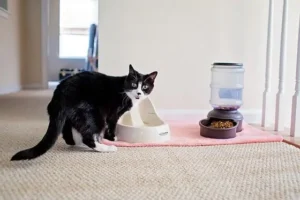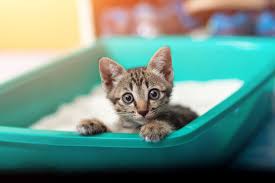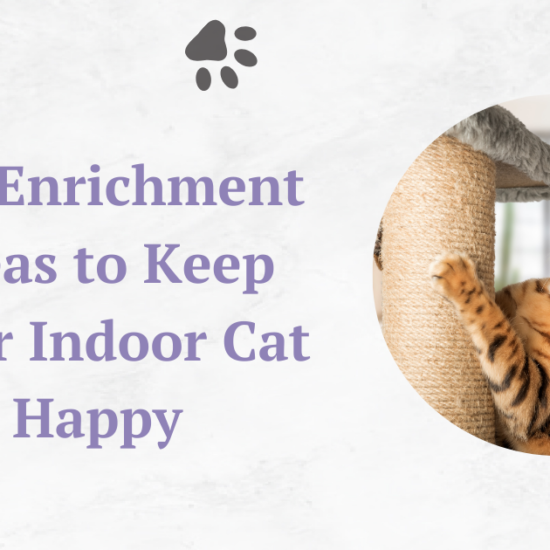Litter box training is an important part of cat ownership. Understanding how to potty train a cat is vital for maintaining a clean and peaceful living environment, whether you’re a seasoned cat owner or a first-time feline enthusiast. A well-trained cat not only keeps your home free of unattractive and odorous messes, but it also helps you and your beloved pet maintain a happy and healthy connection.
Table of Contents
Introduction
We will go deep into the realm of litter box training for cats in this detailed guide. We’ll go over everything from how to potty train a cat to how to choose the correct litter and box to how to solve typical problems that may emerge during the training process. By the end of this article, you’ll be well-equipped to effectively litter train your cat and keep your home clean and odor-free.
Understanding the Natural Instincts of Cats
Cats, our mysterious feline companions, are instinctive creatures. Their conduct stems from their evolutionary history and biology. To understand how to train a kitten to use a litter box, it is critical to understand these basic tendencies that define their toileting routines. These insights will help you get answers to how to potty train a cat successfully.
- Importance of Gut Feelings

Cats, who are often praised for their independence, are motivated by instinctive impulses that influence their daily activity. These reflexes have been embedded in their genetic composition for thousands of years. Understanding these behaviors is the foundation upon which we may create a successful litter box training plan.
The drive to establish territory is one of the most fundamental components of a cat’s instinctive behavior. This territorial urge is what drives their desire to designate their territory. This act of marking, which involves urinating and defecating in specified regions, has a twofold role in the wild. First, it alerts other cats to their presence and status. Second, it claims control over their domain.
- Delineating Territory

The process of marking territory through urination and excrement is a totally natural behavior that can become a cause of frustration when it occurs in our homes. Recognizing the significance of this instinct is the first step toward properly guiding it to a designated litter box.
It is critical to divert this territorial tendency into the litter box in the controlled environment of your home. By providing a defined area for your cat to indulge in this natural act, you are assisting them in fulfilling their desire to establish territory in a more convenient manner for both of you. This act of territorial marking within the litter box is essential to their psychological well-being and pleasure.
- Cat’s Cleanliness Preference

Cats are well-known for their rigorous grooming habits and preference for clean habitats. This obsession with cleanliness extends beyond their fur to their entire living environment. Your quest on how to train a kitten to use a litter box cannot be complete without cleanliness. Cats are naturally drawn to clean environments, and they are more likely to utilize a litter box if it fulfills their hygiene criteria.
Neglecting the cleanliness of the litter box might result in a phenomenon known as “litter box aversion,” which means your cat may begin to avoid the box entirely, preferring to excrete outside of it. This aversion may be a result of the cat’s inherent desire for cleanliness; if the litter box is unclean or the litter is not up to their standards, they may seek out cleaner alternatives, much to the chagrin of their human caregivers.
Selecting the Best Litter and Litter Box
Litter box training for cats is a multifaceted process, and the decisions you make about the type of cat litter, as well as the form and size of the litter box, are critical to the overall success of this training venture.
- Cat Litter Types
The selection of cat litter should be done carefully. There are various sorts of cat litter, each with its own set of benefits and drawbacks. Understanding these alternatives is the first step toward making an informed decision that meets your cat’s preferences as well as your own criteria, such as odor control, simplicity of cleaning, and cost-effectiveness.

Clumping Litter: Clumping litters are popular because they create solid clumps when exposed to moisture, making it easier to scoop waste and keep the box clean. However, some cats may be allergic to the dust that clumping litters produce.

Non-Clumping Litter: Non-clumping litters are created from materials such as clay and are often less expensive. When compared to clumping litters, they may necessitate more frequent entire litter changes and may be less successful at controlling odors.

Silica Gel Litter: Silica gel litter is well-known for its outstanding moisture absorption and odor control. It is sometimes more expensive, but it requires fewer litter changes, making it more cost-effective in the long run.
Natural Alternatives: Natural alternatives such as wood pellets and corn-based litter are available for eco-conscious cat owners. These biodegradable litters are an environmentally friendly solution. Their effectiveness in odor control, however, varies.
Your cat’s preferences and any sensitivities it might have will determine the best cat litter for them. It also depends on your cleaning preferences and financial limits. Experimenting with different sorts of litter will help you figure out which one is ideal for your particular situation. You will eventually find the right solution for how to train a kitten to use a litter box.
- Litter Box Designs

Litter boxes are available in a variety of forms to accommodate diverse tastes, both for cats and their human caregivers. It’s critical to consider your cat’s comfort as well as your personal cleaning habits when selecting a litter box.
Basic Rectangular Pans: The most basic and straightforward type of litter box They are simple to clean and frequently inexpensive, making them a popular choice among cat owners.

Covered Boxes: Covered litter boxes include a hood or lid that can help keep odors contained and litter from being kicked out. Some cats, however, may feel trapped in these enclosures, and scents may get concentrated within.

Self-Cleaning Litter Boxes: These boxes automate the scooping process, saving you time and effort. While they are convenient, they may necessitate a larger initial expenditure, and some cats may be wary of the noise and movement of the self-cleaning system.
- Size of the Litter Box

The size of the litter box is an important factor to consider during litter box training for cats. It has an immediate influence on your cat’s comfort and convenience of use. A properly sized box allows your cat to turn around easily, dig a hole for burying waste, and maintain a sense of security. Low sides make entry and leaving easier for kittens and senior cats, creating a positive litter box experience.
Multiple litter boxes are required in households with multiple cats. To avoid territorial disputes and to guarantee that each feline has a clean and available location for their toileting needs, one box per cat plus an additional is a decent rule of thumb.
Choosing the correct litter and litter box may necessitate some trial and error, but the time spent making informed decisions can pay off in the long term by creating a comfortable and clean environment for both you and your feline companions.
Setting Up the Litter Box
When it comes to how to train a kitten to use a litter box, the environment plays a crucial part in the answer. The location and care of litter boxes are critical components of successful litter box training for cats. You may develop appropriate litter box habits and establish a pleasant bond between your feline partner and their allocated location for elimination by setting the right environment for your cat and continuously guaranteeing its cleanliness.
- Location is Important

The litter box’s location is equally as critical as the box itself. Where you put it has a big impact on your cat’s propensity to use it. Consider the following variables when deciding on the ideal location:
Quiet and Low-Traffic Area: Cats enjoy seclusion when it comes to toileting. Choose a calm, low-traffic location in your home where your cat will not feel bothered or intimidated. This tranquil setting encourages them to utilize the litter box on a regular basis.
Separation from Food and Water Bowls: Cats have a natural tendency to separate their eating and excretion regions. Keeping the litter box apart from their food and water bowls honors their instinctive habit and adds to their comfort and sense of well-being.
- Tips for Placing Litter Boxes

Consider the following placement suggestions to encourage your cat to use the litter box on a regular basis:
Avoid High-Traffic Areas: Using the litter box in high-traffic areas, such as corridors or main living areas, may make your cat feel nervous. Choose a more secluded place to provide them with the privacy they require.
Keep the Box Away from Noisy Appliances: Cats have keen hearing and can become startled by noisy appliances like washing machines or dryers. Placing the litter box in a less noisy area of the house will help reduce interruptions and aversions.
Ensure Kitten and Elderly Cat Accessibility: It is critical to consider the needs of all your feline family members. Make sure the litter box is easily accessible for kittens with lower sides and elderly cats with mobility issues. This encourages inclusivity and keeps your cats from feeling excluded or stressed.
Provide Seclusion: Cats want seclusion when using the litter box. Placing the box in an area that provides some isolation, such as a quiet corner or a separate cat room, can put your cat at rest and lessen the likelihood of accidents.
Note: There might be affiliate links mentioned here. We may receive a commission if you purchase a product through an affiliate link. There is no additional charge for you. Please do your own research before making any online purchases.
- Keeping Things Clean
Keeping a clean litter box is essential for successful litter box training. Cats are more inclined to utilize a clean litter box, and ignoring cleanliness can result in aversion and incorrect elimination. Here are some things to keep in mind:

Consistent Scooping: Establish a routine for scooping waste from the litter box. Scoop it at least once a day to eliminate filthy litter and keep the box looking clean and attractive. Regular scooping also allows you to keep track of your cat’s health by observing any changes in their feces.

Changing Litter: The type of litter you use, the number of cats in your home, and your cat’s habits all affect how frequently you change your cat’s litter. Certain litters necessitate more frequent adjustments than others. Follow the manufacturer’s instructions and make any necessary adjustments.

Cleaning the Box: You should wash the litter box on a regular basis using mild soap and water to remove any leftover odors and residues. Before refilling it with new litter, make sure it’s completely dry.
Step-by-Step Procedure for Litter Box Training For Cats
Litter box training is an essential part of being a responsible cat owner. Whether you’re bringing a new kitten into your house or trying to change the habits of an adult cat, following a step-by-step method is essential for peaceful cohabitation. In this section, we will look at techniques for both kittens and adult cats, emphasizing the need for positive reinforcement and patience. Keep reading to find the perfect answers for how to potty train a cat.
- Kitten’s First Visit to the Litter Box

Litter box training kittens is typically easier than training older cats. Their adaptability and curiosity work in your favor. Here’s a step-by-step solution on how to train a kitten to use a litter box:
Begin Right Away: Begin as soon as you bring your kitten home. In their new environment, familiarizing them with the litter box should be a primary focus.
Timing: After meals, upon waking, and after play are all good times to put your kitten in the litter box. Kittens frequently require elimination following these activities.
Simulate Digging: Scratch the litter softly with your finger to simulate digging to teach your kitty the procedure. This tactile feeling aids in their association of the litter box with the process of elimination.
Positive Reward: Shower your kitty with praise and attention when he or she successfully uses the litter box. As an incentive, provide little goodies. This positive reward reinforces the link between the litter box and the desired behavior.
- Adult Cat Training

Litter box training for older cats might be more difficult, especially if they’ve formed bad habits or have been in other living situations. Here’s a step-by-step guide to how to train a cat to use a litter box:
Health Check: Consult a veterinarian to ensure your cat’s health. Check for any underlying medical conditions that may be causing the litter box troubles. This is an important step because medical issues can have a substantial impact on a cat’s toileting behavior.
Introduce the Cat to the Litter Box: Place the cat gently in the litter box. Allow them to investigate the box and litter. Some cats may require time to adjust to their new surroundings, so be patient.
Positive Rewards: Provide immediate positive rewards when your adult cat uses the litter box correctly. Praise, soft strokes, and even little rewards can help foster a healthy relationship with the litter box.
Patience and Consistency: Maintain patience and consistency throughout the training process. This may take some time, and your cat may experience several setbacks along the way. To avoid aversion, keep the litter box clean.
- Positive Rewards and Encouragement

The key to successful litter box training is positive reward. It is very important for developing your cat’s behavior. Here’s why it’s critical:
Verbal Admiration: Verbal praise, affectionate pets, and encouraging words are all appropriate when your cat uses the litter box correctly. Make it a fun experience for them.
Treats as Rewards: Treats as rewards are an effective motivator. Rewarding your cat with a small treat every time they appropriately use the litter box encourages the behavior.
Never Punish Your Cat: Never punish your cat for accidents or improper elimination. Punishment can increase dread and anxiety, exacerbating the condition. Your cat may associate the punishment with the litter box, making it less likely that they will use it.
Patience and Consistency: The road to successful litter box training can be challenging and annoying. Maintain patience and consistency in your approach. Keep seeking the answers for how to train a cat to use a litter box and use them. It is critical to keep the litter box clean and the environment conducive to successful training.
Identifying and Resolving Common Litter Box Issues
Litter box problems can be aggravating for cat owners, but they are typically resolvable with a little patience and the appropriate approach. Understanding the fundamental causes of these issues is the first step toward properly addressing them.
- Aversion to the Litter Box

When a cat begins to avoid using the litter box, this is known as litter box aversion. This might happen due to a number of factors, including cleanliness, litter type, box location, or previous traumatic events. To overcome litter box aversion, use the following steps:
Maintain a Clean Box: The cleanliness of the litter box is critical. Maintain a clean environment by scooping trash on a daily basis. Change the litter on a regular basis. Cats are more likely to use litter boxes that are clean.
Experiment with Different Litter Types: Cats have very specific preferences when it comes to litter. Consider clumping and non-clumping litters, as well as natural alternatives such as wood pellets. Your cat might have a favorite.
Consider Box Placement: The position of the box is important. If it’s in a busy or noisy place, your cat might avoid it. Try transferring the box to a more private, quieter spot.
Address Traumatic Experiences: If your cat has experienced a traumatic experience in or near the litter box, such as a loud noise or a fight with another pet, they may connect the box with fear. You can gradually reintroduce your cat to the litter box, using positive reinforcement to establish pleasant connections.
- Improper Elimination

When a cat urinates or defecates outside of the litter box, this is known as inappropriate elimination. This could be a reaction to a variety of stressors or pain. To address incorrect elimination, take the following steps:
Rule Out Medical Issues: Before anything else, see a veterinarian to rule out any underlying health issues. Medical conditions such as urinary tract infections or kidney difficulties might cause discomfort, leading to this behavior.
Consider Stressors: Cats are extremely sensitive to environmental changes. Gradually introduce environmental or home changes. New pets, a change in routine, or altering furnishings can all cause inappropriate elimination. Addressing these pressures can aid in the resolution of the condition.
Gradual Changes: Make changes to your home gradually, such as switching to a different type of litter or changing the litter box. Cats frequently require time to adjust to changes.
Reapply Training Tactics: If your cat has begun eliminating outside the litter box, you may need to reapply litter box training tactics, particularly if they have acquired a strong aversion. Encourage children to utilize the box on a regular basis by using positive reinforcement.
- Health Concerns
Health issues might make litter box issues worse. If your cat suddenly stops using the litter box, you should consult a veterinarian to rule out any underlying medical concerns. Urinary tract infections, kidney disorders, and arthritis can cause pain or discomfort during elimination, prompting your cat to avoid using the litter box. Treating the underlying health issue is frequently the most effective strategy to resolve litter box issues caused by medical conditions.
FAQs
How can I tell which litter is best for my cat?
Your criteria and your cat’s preferences will determine the litter you choose. Experiment with different varieties to determine which one your cat loves, such as clumping, non-clumping, silica gel, and natural alternatives. Consider things like odor control, cleaning ease, and cost.
What is the best place to put the litter box?
Choose a calm, low-traffic place with plenty of seclusion. Keep it away from your cat’s food and water bowls because cats prefer to keep these locations distinct.
How frequently should I clean the litter box?
To keep a clean box, scoop waste on a daily basis. Regular scooping is vital for encouraging your cat to use the litter box on a regular basis.
What should I do if my cat has acquired a phobia of the litter box?
Make sure the litter box is clean, and try out different types of litter. If required, relocate the box and provide positive reinforcement to address any previous traumatic events.
How to train a kitten to use a litter box?
Begin as soon as you get your kitten home. After eating, waking up, and playing, place them in the litter box. When kids utilize the box appropriately, provide positive encouragement.
What if my adult cat refuses to use the litter box?
First, see a veterinarian to rule out any underlying health issues. Introduce your cat to the litter box gently and provide positive feedback for proper use. Train with patience and consistency.
Should I ever discipline my cat for accidents in the litter box?
No, you should never penalize your cat for mishaps. Punishment can increase dread and anxiety, exacerbating the condition. Maintain your patience and use positive reinforcement.
What if my cat has begun to eliminate outside of the litter box?
A vet visit can rule out any medical issues. Consider any recent stressors in your cat’s environment and implement changes gradually. Positive reinforcement should be used to reintroduce litter box training practices.
How can I tell if a medical condition is the root of my cat’s litter box aversion?
Unexpected changes in litter box behavior should trigger a visit to the veterinarian. Medical conditions such as urinary tract infections, kidney difficulties, and arthritis can cause discomfort and aversion.
How many litter boxes will I need if I have numerous cats?
In a multi-cat household, one litter box per cat plus one extra is a decent rule of thumb. This prevents territorial disputes and ensures that each cat has a clean and accessible toileting area.
Conclusion
Cat litter box training is an important element of responsible pet ownership. It provides a clean and peaceful living environment for you and your feline companion. Understanding how to potty train a cat by understanding your cat’s instincts, selecting the correct litter and box, and keeping the litter box clean are the foundations of successful litter box training.
Remember that the keys to success are patience and good rewards. Cats are intelligent and adaptable animals, and even the most difficult instances can be resolved with the appropriate approach. Finally, a well-trained cat results in a happier and healthier relationship between you and your cherished pet.












